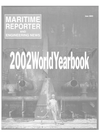
Tanker Market is Solid
The year 2001 must be described as a very healthy year for tanker owners. Although it is a fact that freight rates for all tanker types have fallen substantially and continuously through the year, the average rates for the year have been quite strong. For product tankers of various sizes, 2001 was even better than 2000.
Rates for medium sized crude carriers were moderately weaker, while for VLCCs they dropped significantly. Despite declining freight rates for crude carriers, the profitability for all tanker was, for the second consecutive year, remarkably high.
Modern VLCCs started the year at an incredible $70,000/day on the spot market.
Almost immediately, however, the declining trend set in which was to last all through the year except for a brief upturn in September.
As an average for the whole year, modern VLCCs obtained $35,000/day, down from $53,000/day in 2000. Old VLCCs reached $20,000/day, compared with $33,000/day in 2000. Medium sized tankers followed the same declining trend as VLCCs, with earnings at $50-60,000/day at the beginning of the year and at $20,000/day at the end of the year. However, the fall in average freight rates was far more moderate than for VLCCs. Both Suezmaxes and Aframaxes obtained, according to Platou calculations, $32,000/day in 2001, down from $40,000 and $37,000, respec- lively in 2000.
The peak year for product carriers was 2001, not 2000. Aframax clean carriers (LR2) last year obtained the highest tc result for any type of tanker, $41,000/day, which was $9,000 above the 2000 level. Panamax clean carriers (LR1) reached $32,000, up $6,000 from the year before, while the MR type rose from $16,000/day in 2000 to $18,500/day in 2001.
The active tanker fleet increased by .9 percent from 2000 to 2001, calculated on an annual average basis. The active VLCC fleet increased by .5 percent, while the rest of the tanker fleet grew by one percent. Deliveries of new tankers reached 13 million dwt in 2001 (of which, 26 were VLCCs), a relatively low figure compared with deliveries of 21 million dwt per year in the previous two years. Approximately 15 million dwt were sold for scrapping in 2001, and four million dwt were sold for conversion.
A decrease of two percent or more in tanker tonnage, combined with only a modest increase in the active tanker fleet means that there should be a further two to three percentage points drop in utilization rate.
Source: The preceding was excerpted, in part, from The Platou Report 2002. The segment on The Tanker Market was authored by Erik M. Andersen, R.S. Platou Economic Research a.s. R.S. Platou Shiphrokers A.S. is headquartered in Oslo, Norway, and can be contacted by: tel: +47 23 11 20 00; fax: +47 23 11 23 00; or on the Worldwide Web at www.platou. com.)
Other stories from June 2002 issue
Content
- Bollinger To Acquire Halter Marine page: 6
- Bidding War Comes to an End page: 6
- Jotun And NOF Marine Coatings Join Forces page: 8
- Thunder Horse Will Get Wartsila Generators page: 10
- United Defense to Acquire United States Marine Repair page: 10
- New Order For MAN B&W Diesel ME-Engines page: 12
- Fares Al Salam Parts The Red Sea page: 14
- Redundancy The Next Watchword? page: 20
- Cargo Handling's New Force page: 22
- A Naval Architect's Look At Design Trends page: 24
- Conoco Leads The Way For GOM Shuttle Tankers page: 27
- Daewoo Shipbuilding To Build, Refit LNGs For Exmar page: 27
- Navy League Comes to NY for Centennial Celebration page: 28
- Prospects Abound, But Where's the Money? page: 32
- OPA '90 - The Oil Pollution Act of 1990 page: 33
- Container & RoRo Tonnage — Non-Contiguous Liner Trades page: 35
- Matson Signs $220M Contract With Kvaerner Philadelphia page: 38
- GL: Exporting German Precision page: 40
- World Shipbuilding to Fall Slightly page: 44
- Tanker Market is Solid page: 45
- Bergesen Releases 1Q Results page: 46
- OMI Announces 1Q Results page: 47
- MAN B&W Turbocharger Technology Unveiled page: 49
- Answering the Call from Above page: 50
- Thrane & Thrane Offers Capsat Fleet77 page: 53
- Crisis Management and the Integration of Vessel Tracking Technologies page: 60
- Rear Admiral Pluta Redefines Maritime Security page: 64
- Ship Graveyard page: 68
- Intertanko's Sustainable Challenge page: 72
- German Barging: Over the Divide page: 76
- Blohm+Voss: 125 Years Young page: 80
- Thordon Makes Inroads With COMPAC Shaft Bearing page: 90
- Halifax Lays Keel For First of Two OSV's page: 91
- Owners Approve White Rose Oilfield page: 91
- Voyage Data Recorders page: 92
- Titan Re-Floats IMaersk La Guaira page: 96
- Austal USA Enters Repair Market page: 96
- Maritime Industry Remembers Nealis page: 97

